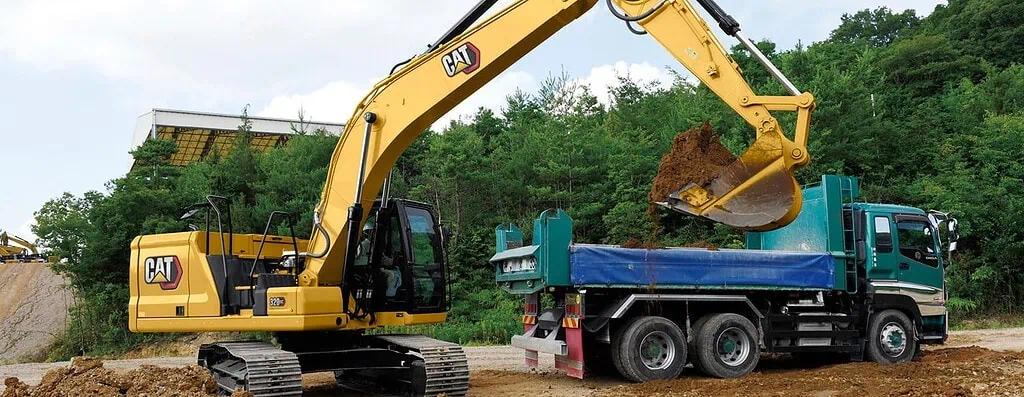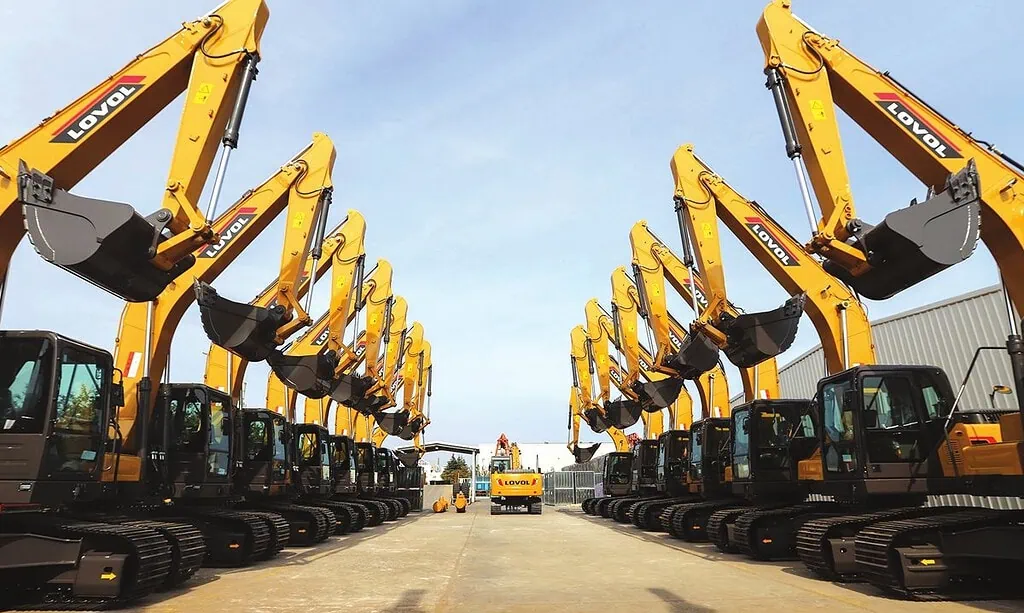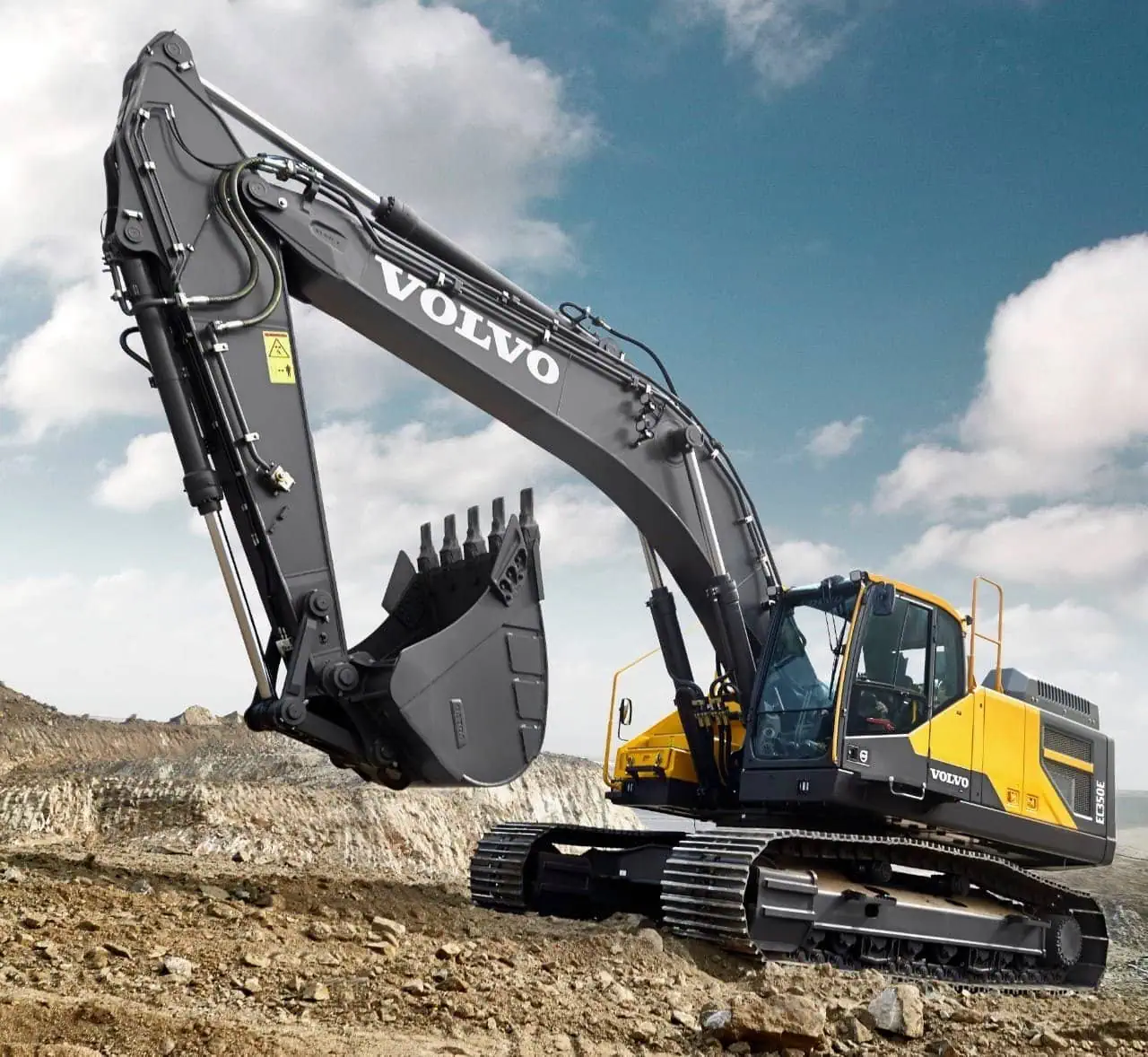Are you curious about the critical role excavators play in construction? These powerful machines are essential for everything from digging foundations to preparing a site. Understanding their functions can help you optimize how you use them on your construction projects.
Are indispensable excavators in construction, facilitating various tasks such as digging, grading, and demolition. Their versatility allows for efficient site preparation and utility installation, ensuring projects run smoothly. With different types available, selecting the right excavator can significantly enhance productivity and safety on the job site.
Let’s take a look at the many uses an Bagger has in the construction industry.

Inhaltsverzeichnis
UmschaltenWhat Types of Excavators Are Commonly Used in Construction?
There are different types of excavators specifically designed to perform particular tasks. Crawler excavators are ideal for uneven terrains or large projects. They provide stability and power. Because they run on tracks instead of wheels, they can handle rougher terrain and provide better stability. Crawler excavators are useful for heavy-duty applications, like mining and big construction projects. Wheeled excavators provide maneuverability for urban projects in tight spaces, where it’s necessary to move from one site to another quickly. You drive a crawler excavator;
you can move a wheeled excavator to another site. Mini excavators are for small areas, such as those found in residential landscaping or for utility work. They are highly maneuverable, yet capable of performing tasks like digging and trenching. Each of the different types of excavators has a specific use, so you can choose which one is best for your project requirements. Understanding the characteristics and capabilities of the different types of excavators can help you be more efficient and productive on your job site.
How Do Excavators Facilitate Site Preparation?
Site prep is a huge part of construction, and excavators are a critical part of this process. Attorneys clear the site and grade the ground. They dig ditches for footings or foundations. Often, this process includes removing topsoil, leveling uneven areas, and making sure the water drains properly. However you look at it, the excavators get the work done and get it done right. Efficiently prepping the site and getting construction crews working is a priority in any situation. Properly preparing the site ensures a solid foundation for the project.
This requires an excavator to do the dirty work. They can use different types of attachments, such as buckets, or just the back end of the machine, called a rake, to get things cleaned up and squared off. Excavators are great for adapting to different conditions, and can clean up and finish a site in no time flat. Also, the excavators can eliminate a lot of the manual labor involved. Skilled hand crews will always be needed to finish the exact work, but excavation greatly reduces the amount of time those crews need to spend cleaning up the site. This means they work safer, without getting as tired or injured, and your project gets started quicker.
You can use the excavators to create temporary roadways and paths for the equipment as you start pulling everything onto the site and placing it. They will also use the excavator to help clear areas and make it safer for people to work there, again, we do not want somebody tripping over a brick paver we just tossed into the woods last week.
That can lead to delays, cause an accident, or push your schedule back. They can also use the big machines to create ditches to move water around the site, or ramps and swales to direct that water off the site and stop soil erosion. Once the maintenance all the areas are in place, you have a beautiful clean site with all the right drainage and no soft areas for people and machines to get stuck.

In What Ways Are Excavators Used for Digging Foundations?
Excavating for foundations is something at which the excavators absolutely excel. Using a big trench bucket, you can dig a hole twenty, thirty, or seventy feet deep for a large structure. A backhoe digs with precision.
If you have to be five feet deep, it will dig five feet and have a five-foot stretch. They are invaluable when digging the hole for the foundation, spotting the grade stakes so you’re not too deep, or not doing things in precisely the right direction at the right width, which is very important when creating a foundation for a large building where the following structure, your workplace or somebody’s residence, better be on the level! Big machines can dig a hole quickly and efficiently using intelligence to make sure everything is at the right grade.
Also, using people instead of machines to dig the hole could create a trench collapse, which can be a very concerning hazard as you are working in the neatest pile of dirt possible. Or big machines make sure you fill in the hole correctly, pipe everything properly, and make sure all the levies and walls are in the right location to have water drain and drain properly. Once you use a machine to dig the hole, you can make it fancy and make the corners occur at crazy angles so you can carve out where every exterior corner of the building will touch down.
Using people to dig a hole takes a lot longer, is a lot more dangerous, and a lot more hazardous to the environment. People will get tired, and the hole makes them constantly battle collapses. Or big machines bury you, and fill the hole back in. They are also able to provide the exact specifications you need for the hole, where the interior and exterior corners are located. The last machines also allow for a lot of room to play with.
Using a big hoe, you might also install a laser that assists in sticking the blade to the exact level at which you want the interior and exterior wall of the foundation. You are now bringing technology into play that will help you get the foundation right, the first time. Most foundation jobs require the use of people and machines to accomplish this task. Today, a lot of the grating work used to complete the foundation grading and finalize the soil requirements is completed using the bucket of the backhoe.
Than that excess dirt removed from the site keeps it spotless and ready for the foundation plank boards to be set in place, stakes to be positioned, or concrete ready to be arrived. All of these excavation services can be performed by large machines, much faster and more precise, than otherwise attempting to do the same job by hand. Use your thinking caps and do a lot of smiling when you ask how you can use your backhoe to accomplish site work. You get so much of the quicker and cheaper task.
How Do Excavators Contribute to Demolition Projects?
There comes a time when it is more economical to tear a building down to the ground and start anew. No matter the method used, a big shovel (excavator) can help you get it done. Even using the back of the machine for difficult teardowns to remove a chimney, it can knock down buildings and call it a day. They could build a concrete platform in front of a brick house and then push the house down and crush it on the platform. Confine the debris, then turn it back through the machine for rebuilding.
There is no need for a track machine to carry debris for any length of time or to set aside the small rubble to later pick it up. All your large demolition tasks, concrete bridges or asphalt surfaces could be broken up with a bucket, a hammer, or hand-jaw machine. These tools can be utilized to perform various other tasks. Use the weight of lease lumber, because it’s legal to tear down any old barn or structure.
The hammers make light work of tearing down the walls and foundation Once you get the majority of the structure knocked down, you can use the grapple on the back of the large machine to move the material to a burn pile and out of the way. Summing it up; the big machine does a fantastic job with any kind of demolition work you might have on your projects. The tools and equipment you add to the machine only enhance what you can do with a great piece of construction machinery.
Furthermore, excavators work in tight places, specifically in town or urban jobs. They can raze a building or a factory to the ground—everything is gone. The back end of the machine has fingers, a hammer, or a saw to remove everything else you see, including the trees and bushes. You ensure that every root and stump is removed, and the ground is flat when you finish.
Also, every piece of debris can be placed in a burn pile to get ready for transport, but you must be extremely careful during demolition to adhere to safety considerations. You will be good to go in no time if you hold every piece of debris in front of you until you see it drop down into a big pile. All the debris—not a one-inch piece—touches the ground before you leave; anything else is crazy and irresponsible. You would hate to trip over a piece of debris that you didn’t knock out of the way before leaving the fence.
Using a big machine in demolition work means working with a track machine. In the world of tearing things down, you will need some extra hydraulic hammers and tools to help you with the project. This machine is perfect for any job you can imagine. Use it to work efficiently and quickly, whether you have to require a ditch, build a road, or tear down a building.
What Role Do Excavators Play in Utility Installation?
When it comes to installing utilities like water, gas, and electricity, excavators are indispensable. Their precise digging capabilities allow for accurate trenching, ensuring that pipes and cables are installed safely and efficiently. This functionality is crucial for meeting local codes and regulations, which often dictate specific depths and placements for utilities.
Excavators also help minimize disruption to the surrounding area, maintaining a smooth workflow during utility projects. They can quickly switch attachments to perform different tasks, such as trenching for pipes or lifting heavy utility boxes, making them highly efficient on the job. The ability to dig trenches with minimal soil disturbance helps protect existing landscaping and reduces the overall environmental impact of the installation process.
Furthermore, with the right attachments, an Bagger can even do the work of a specialized utility installation machine. With a trencher attachment, an excavator can create a narrow, deep cut for a pipeline or electrical conduit. Or, using a rock saw attachment, an excavator can cut a wider trench in hard soil that would be trouble for a normal trencher. This machine’s flexibility means you can save time on your installation, dig a straighter, neater trench, and avoid damaging other utilities already in the ground.
How Are Excavators Used in Landscaping?
Landscapers move a lot of dirt and materials around with excavators. This shaping ability is critical in creating parks, gardens, and other outdoor spaces. They use excavators to dig ponds, grade lawns, clear ground for planting, and to perform many other tasks. Speed and efficiency, which are hallmarks of these capabilities, allow them to do this work about a zillion times faster than they could by hand. And their precision carries through to an ability to ensure that the landscape they “build” meets the original design’s specifications.
These machines can also handle the heavy lifting involved in removing trees and stumps, along with other landscaping tasks that require a lot of force or reach. The bottom line: excavators make it possible to create spectacular landscapes while dramatically decreasing labor costs and time requirements.
Landscaping attachments like augers make excavators even more valuable because you don’t have to swap out machines to dig a hole for a tree or shrub. You also don’t have to find a place to store a bunch of different machines. Versatility like this simplifies project management.
What Safety Considerations Are Important When Using Excavators?
Don’t forget that these machines can hurt people. You have to have good safety precautions in place. Make sure the machine is serviced and maintained well. Nothing creates accidents like a mechanical failure on a piece of heavy equipment. The operator also has to know what they’re doing and be aware of what’s going on around them.
Make sure they’re aware of what’s overhead, where the power lines are, and where the ground might be unstable. Lastly, ensure that the people on your team are properly trained and conduct regular safety drills with your team. Put technology to work by utilizing in-cab cameras and sensors to help operators more effectively monitor their job site surroundings, reducing the odds they’ll have an accident. Build a culture of safety inside your company. Encourage people to report near misses and then take corrective action to prevent those near misses from happening in the future.

How Is Technology Transforming Excavators In Construction Usage?
The construction industry has embraced new technology in the form of smart excavators, which are equipped with high-level features like GPS tracking, automation, and advanced hydraulics that increase efficiency and accuracy. GPS technology lets the excavator work with precision as it knows where it is and can dig to exact specifications. The use of automation features not only helps when doing repetitive tasks, but also reduces the physical toll on the operator and increases overall production.
These smart excavators are becoming even smarter as manufacturers program them to take data and adjust the machine’s operation in real time, taking over some of the work that the operator would normally perform. These kinds of innovations help you be more productive, but they are also safer because the machine automatically helps prevent the kinds of performance mistakes people make. The telematics systems that come standard on most new machines also provide big value. You can use this data to monitor the performance and health of your machine, getting alerts when something’s going wrong. This proactive maintenance approach can help you avoid costly downtime.
Companies in the construction industry are even using machine learning algorithms to help them make good decisions. They collect all of the performance data from their fleet and use AI to make decisions on how to operate better and save costs. As technology advances, it’s clear that excavators are going to play an even bigger role in the construction of our modern world.
What Are the Environmental Impacts of Excavator Use?
Furthermore, modern excavator design is more eco-friendly. Many of the newer machines are fuel-efficient, which ultimately reduces carbon emissions and the equipment’s impact on the planet. Manufacturers concentrate on making their equipment as earth-friendly as possible. They use recyclable materials in the equipment and recycle scrap metal, which means they consume less new metal to make new machines.
The leaders in the equipment industry are going to great lengths to make sure their machines are as efficient and environmentally friendly as possible. You can choose eco-friendly equipment if your project requires it. You can use alternative fuels, like biodiesel, in many machines. Some operators use electrically powered equipment, which reduces emissions and also eliminates the noise pollution of a fossil fuel engine running all day. When it comes to site management, any time you can minimize soil disturbance, that’s a good thing for the planet.
Also, if there are wetlands or wildlife around your job site, take extra care to protect them from your operations. The sooner your company takes an active role in reducing the environmental impact of its operations, the sooner the construction industry can meet the needs of today without compromising the needs of the future. Use and reuse materials instead of throwing away. Use green building practices wherever you can. Take every opportunity to minimize soil disturbance and protect natural habitats on your job sites.
How Do Excavators Enhance Productivity on Job Sites?
Excavators decrease the time and labor required to do what needs to be done every day on a construction site. You get more bang for your buck because the same machine can dig, lift, grade, and more by quickly changing out an attachment. This versatility means you don’t need as many machines on-site, which saves money, makes the yard look more streamlined, and becomes a competitive advantage for you.
This speed and efficiency are what it takes to make or beat just about every construction deadline there is. But speed isn’t enough. Your team, especially your operators, need training so they can unleash all that an Bagger can do. Additionally, an excavator can provide precision. It can put the material right where it needs to go with very little waste.
The more precise your excavator and the person operating it, the better the overall outcome of the job. Construction projects are getting more complicated all the time. An excavator’s ability to morph into whatever it needs to be is why it’s worth all the money you’re going to spend on it. It not only does a great job, but it also makes the other guys watch their trucks sit in the yard.
Also, better communication on a construction site comes from having a machine like an excavator that can do multiple things. Because you’re using fewer people waiting for fewer pieces of equipment, everything happens better and faster. In fact, your entire project comes in on time and on budget. And if you believe that last phrase, I have a bridge in Brooklyn you might like to buy.

Zusammenfassung
Construction couldn’t happen without these machines. They do all kinds of work. They’re more adaptable now than ever before. They’re smarter now than ever before. And if you use an excavator the right way, you can get more done, make more money, and work safer. For more information or professional advice, feel free to Kontaktieren Sie uns.










